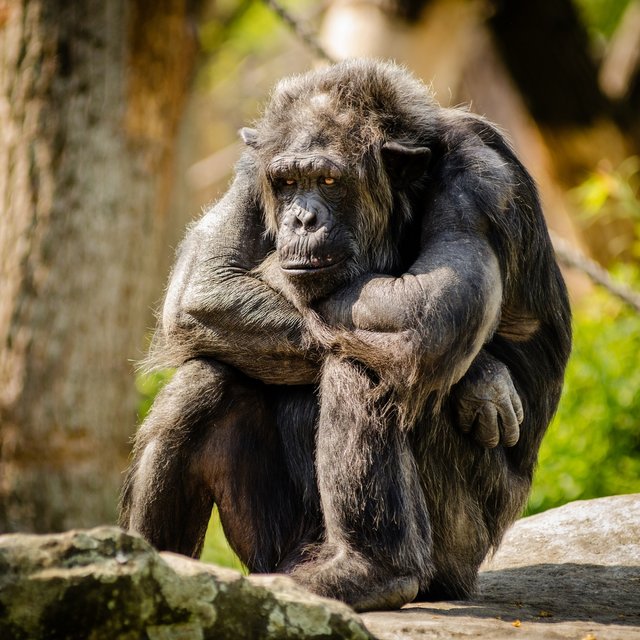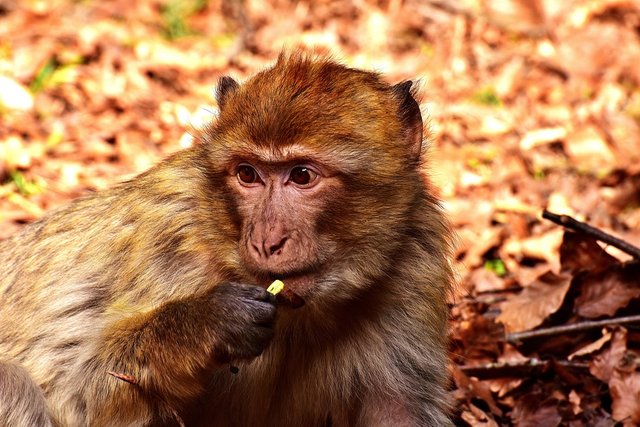Do animals think?

A human likes to consider himself the only being endowed with reason. Although representatives of the animal world are not inferior to us in intelligence, but looking at the amazing abilities of some of them, it is difficult to doubt their ability to think.
Kanzi learned more than 200 words and for mental development corresponds to a child of two and a half years. He understands what he is told, even by phone. All this would not be surprising if Kanzi was not a young bonobo — a dwarf chimpanzee living in the Center for Linguistics of the University of Georgia, USA.
This primate communicates with people, indicating geometric symbols, each of which denotes a specific word. Like all other monkeys, Kanzi can not speak. However, using a system of symbols, he adds up simple phrases, pushing two or three "words" in succession. But does this prove that Kanzi is able to think? The ability to make phrases certainly indicates the significant capabilities of his brain, but this child prodigy seems to have reached its limit. His vocabulary does not expand, and according to his thinking abilities he never compares with a man.
Cunning lazy animals
People have not yet given a clear definition of intelligence. According to specialists in this field, the ability to think is composed of such indispensable components as memory, attention, logic, spatial perception and understanding of verbal commands. Only a few animals have these abilities, although some demonstrate something that strikingly resembles the intellect. For example, when a vulture catches his favorite delicacy — an ostrich egg, he takes a stone into his beak and begins to drop it onto the egg until a strong shell breaks. Salmonids of the Atlantic and Pacific basins, having lived for several years in the open sea, guided by the so-called feeling of the house, unerringly return to the mountain stream where they hatched from the eggs. In Côte d'Ivoire (West Africa), chimpanzee's abilities are even more surprising. The favorite nuts of these monkeys are very hard shells, and they split it with stones. If the stones can be found not far, say, not further than 20 meters, they always choose the heaviest. But if to a suitable placer more than 40 meters, they take smaller stones to make it easier to drag them.

The behavior of vultures and salmon is purely instinctual, inherent in the genetic code and inherent in every individual from birth. But the chimpanzee's effort to save energy clearly demonstrates the ability to "stretch the brains". The spent effort could be calculated according to a formula that would include the weight of the stone and the distance to which it should be dragged, which requires the rudiments of the intellect.
However, chimpanzee's abilities will not seem so incredible if we remember that they, along with gorillas and orangutans, are our closest relatives. Moreover, in the first years of life these monkeys learn much faster than children. They can be taught to eat with a spoon, use a corkscrew and even ride a bicycle. Such early learning can suggest that, with proper education, anthropoid apes could become civilized creatures. However, when maturity is reached, their natural aggressiveness prevails, and adult monkeys, especially males, become dangerous to humans.
Water acrobats
At the Hawaiian station for studying marine mammals, two dolphins perform complex acrobatic tricks. The performance they play is especially striking, because these clever creatures created their program almost independently, with minimal help from the coach. With their heads out of the water, they watch his commands. If the coach crosses the index fingers — it's a "together" signal. Then he waves his hands, which means "started", and the dolphins immediately dive into the depths, float in single file, then simultaneously jump out of the water, raising the spray fountain and succeeding in throwing out a powerful jet of water before flopping back.
Many would say that this is simply the result of a long training, but in fact the coach only orders the team to begin the show, the details of which are unknown to him. The dolphins "are themselves choreographers". And this means that they somehow communicate with each other, agreeing the order of actions: to swim in single file, to collect water, then simultaneously to throw it out. The most impressive thing is that they can react to the same coach team in different ways: to swim in one direction, then in another direction, and sometimes in circles. Obviously, animals have some freedom of choice.
Amazing series
Perhaps the almost perfect coherence of the actions of two dolphins is the result of the habit or imitation of one animal to another. Such behavior forces scientists to search for an explanation easier, otherwise, if we evaluate intelligence by the speed of orientation in a particular situation, we will have to admit for the marine acrobats intelligence, excessive even for humans.
In nature, dolphins behave no less amazingly. For example, a dolphin, nicknamed the fishermen of Percy, was well known off the coast of Cornwall in the south-west of England. Like many of his brethren, Percy loved the company of people: he sailed for fishing boats and approached the scuba divers. One particularly attracted Percy, and he spent hours spinning around him.

The behavior of other animals, perhaps not so spectacular, but often proves to be much more complicated than it seems at first glance. An example is a conversation between a cock and his harem. As the American scientist has observed for many years, sound signals given by a rooster not only declare to females that he has found food, but also report the quality of the find. To test this hypothesis, the scientist offered birds worms, peas and peanuts. Finding worms or peas, the cock called the hens with rapid short signals, to which they immediately ran. And at the sight of peanuts the cock made a lingering sound, expressing disappointment, to which only half of the hens reacted.
Collective mind
The nervous system of insects is arranged quite simply, but their group behavior can work wonders. Many scientists believe that even such complex concepts as time are available to these invertebrates. For example, in the French city of Toulouse, researchers have trained the ants to receive food strictly on schedule and only in certain places. Three times a day a small colony left the nest and headed for three points, where bread crumbs were poured.
No less impressive are the abilities of honeybees to build geometrically correct honeycomb cells for brood and forage stocks. The building material is wax, produced by their own organism. And the division of labor in the hive goes so far that some worker bees serve as fans: continuously vibrating with wings, they create an air current that protects the cells from overheating.
very interesting, my wife is also from Russia. i am now following you
got it
That's a very nice post. If you want my advice, to get better rewards, you may want to include a few references at the end of the post. Thanks in advance for your consideration!
Thanks for the advice. I will use it =)
Resteemed your article. This article was resteemed because you are part of the New Steemians project. You can learn more about it here: https://steemit.com/introduceyourself/@gaman/new-steemians-project-launch
Congratulations @mamasetta! You have completed some achievement on Steemit and have been rewarded with new badge(s) :
Click on any badge to view your own Board of Honor on SteemitBoard.
For more information about SteemitBoard, click here
If you no longer want to receive notifications, reply to this comment with the word
STOP